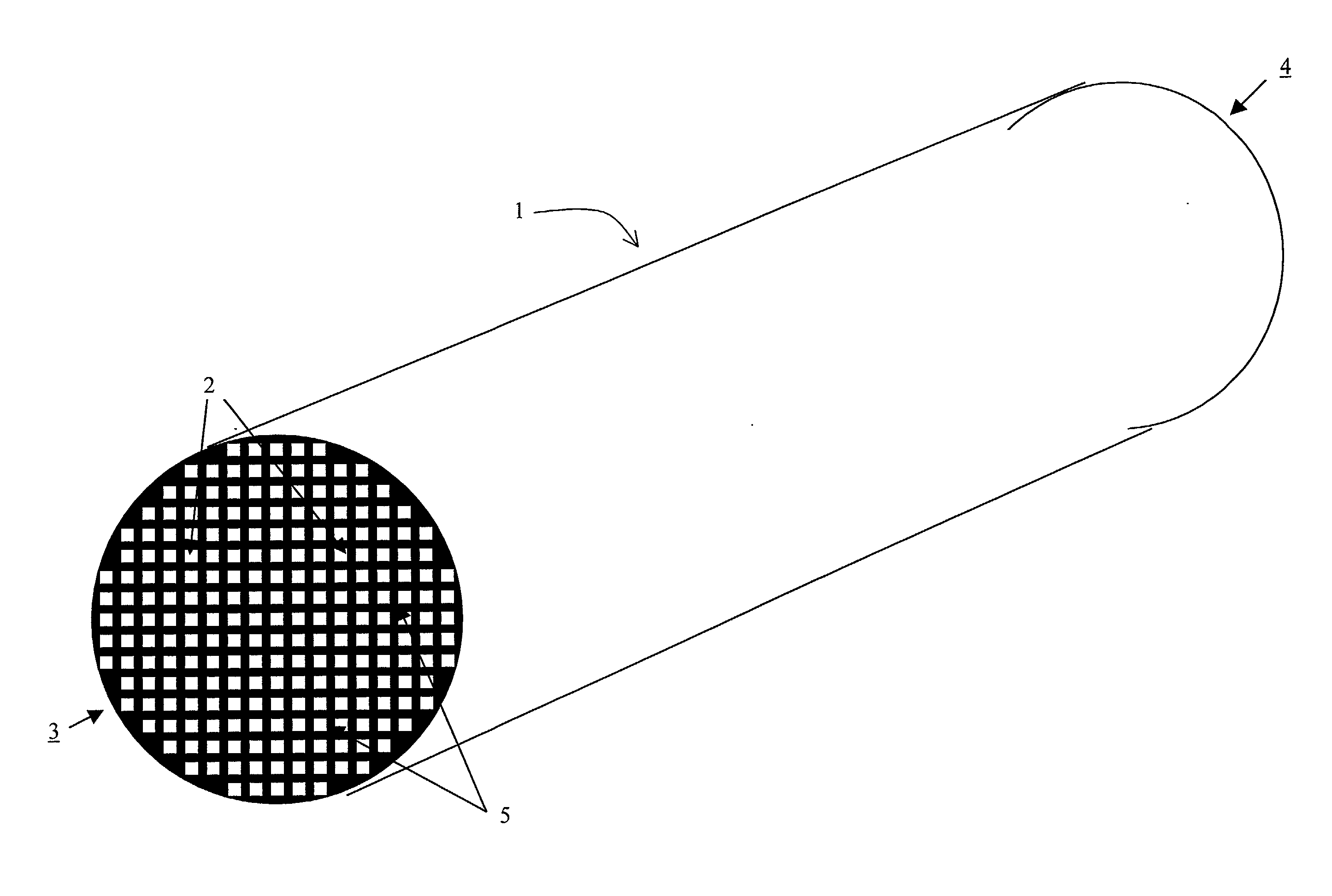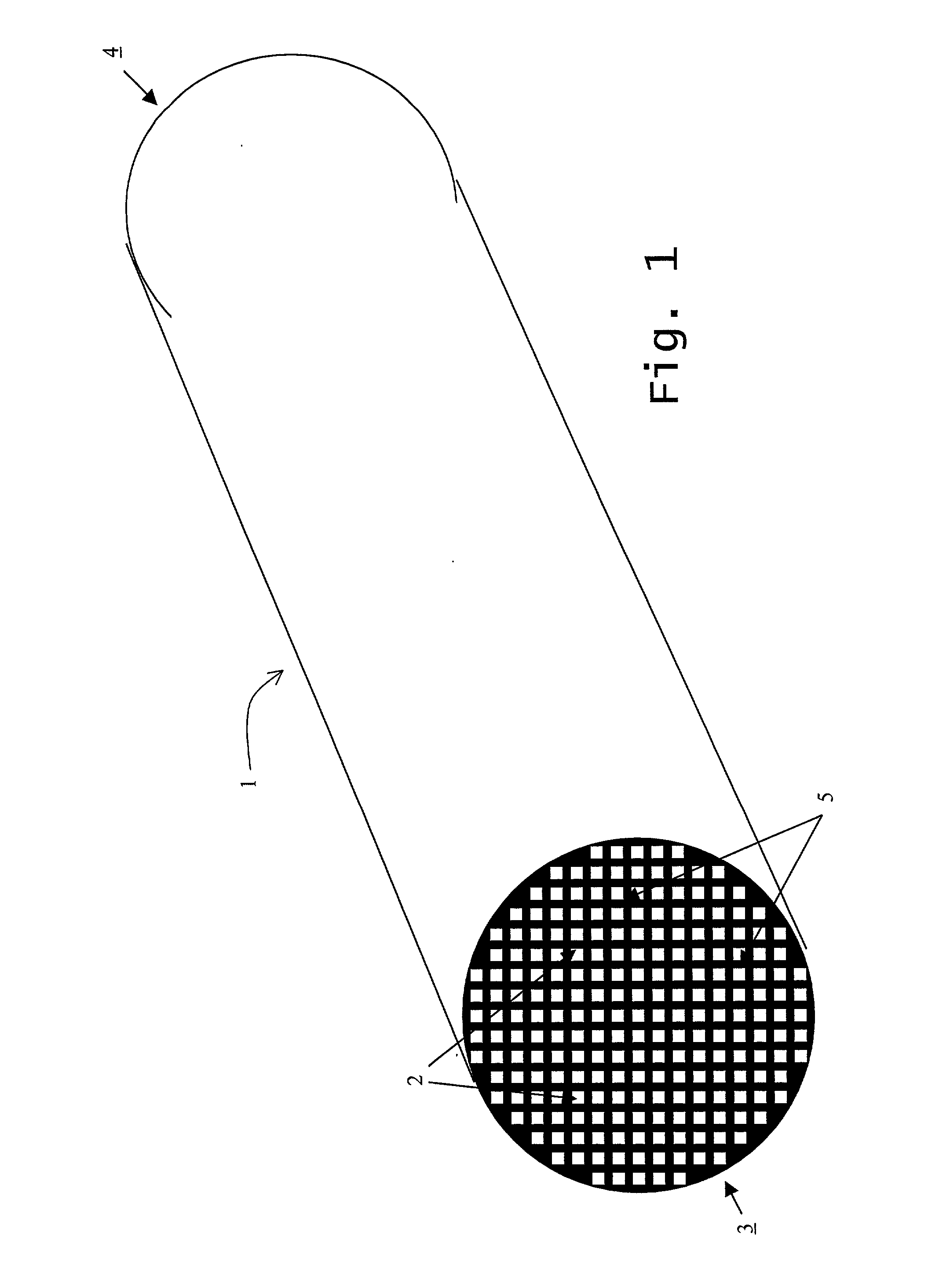Reaction bonded alumina filter and membrane support
a technology of alumina filter and alumina membrane, which is applied in the direction of filter regeneration, dispersed particle filtration, domestic applications, etc., can solve the problems of difficult production of monoliths, especially those with larger diameters and longer lengths, and inferior chemical durabilities of silica-free oxide ceramics, so as to improve the final ceramic properties, improve the surface area to volume ratio, and improve the effect of chemical durability
- Summary
- Abstract
- Description
- Claims
- Application Information
AI Technical Summary
Benefits of technology
Problems solved by technology
Method used
Image
Examples
example 1
[0055] Five 4-g pellets of each mixture from Sample Mixtures 1-6 and of the control Sample Mixture 7 were pressed in a 1-inch diameter die set at .about.14,250 psig. All pellets were sintered in an electric furnace (air atmosphere) according to the following schedule: 2.degree. C. / min to 800.degree. C., 4.degree. C. / min to 1600.degree. C., held for 2 hours at 1600.degree. C., cooled at 10.degree. C. / min. The sintered compositions were as given in Table 1.
1TABLE 1 Compositions of Examples 1-6 Sintered Materials Wt. % 240 grit Wt. % fine alumina Wt. % alumina from Material alumina (d.sub.50 = 0.4 .mu.m) Al metal oxidation Example 1 70 20 Ceralox APA 0.5 10 Example 2 70 20 AlcoaA-16SG 10 Example 3 70 15 Ceralox APA 0.5 15 Example 4 70 15 Alcoa A-16SG 15 Example 5 70 10 Ceralox AIPA 0.5 20 Example 6 70 10 Alcoa A-16SG 20
[0056] The sintered pellets were used for measurements of sintering shrinkage, open porosity, biaxial flexural strength and nitrogen permeability. Mean values of these p...
example 2
[0057] In order to form a composition suitable for extrusion, i.e., with the necessary organic components, the following mixture was prepared: 57.0 g 240 grit alumina (Code 3000 alumina from Saint-Gobain Ceramic Materials)+16.3 g Alcoa A-16SG+4.3 g AL-104 from Atlantic Equipment Engineers were dry-milled under nitrogen for 1 hour, using alumina grinding media, to break up powder agglomerates. After sieving to remove the grinding media, the milled powder was dry blended with 4.2 g MH300 methyl cellulose (Tylose MH 300 P2 from Clariant Corporation). A solution of 1.1-g stearic acid in 4.0 g warm ethanol was added and blended in. A further addition of 0.4-g ethylene glycol was blended in. Finally, 1.1-g of a 7% solution of Elvanol grade 85-82 polyvinyl alcohol (DuPont) and 7.7 g water were added and blended in. Thus, the overall composition of Example 8 was (wt. %): 59.3% coarse 240 grit Al.sub.2O.sub.3 powder; 17.0% fine Alcoa A-16SG Al.sub.2O.sub.3 powder; 4.5% Al metal (AL-104); 4.4...
example 3
[0059] Extrusion of Monolith Substrate Bodies:
[0060] Preparation of Inorganic Components: Coarse Al.sub.2O.sub.3 (4029.0 g of 240 Grit Code 3000 alumina from Saint Gobain Ceramic Materials) was combined with fine Al.sub.2O.sub.3 (1155.0 g of A-16 SG from Alcoa) and aluminum metal (306.0 g of Al-104 from Atlantic Equipment Engineers). This dry mixture was purged with nitrogen (Industrial Grade) in a milling jar for 45 minutes and then mixed in a ball mill with 9.4 mm spherical alumina spheres grinding media for 20 minutes. Methyl cellulose (312.0 g of "TYLOSE" MH 300 P2 from Clariant Corporation) was added to the milled mixture and this dry mixture was stirred for 20 minutes in a 30-quart Hobart planetary mixer.
[0061] Preparation of Stearic Acid-Ethanol mixture: Ethanol (300.0 g of HPLC Grade from Fisher Scientific) was heated to 60.degree. C. on a hot plate and stearic acid (100.0 g of Laboratory Grade from Fisher Scientific) was dissolved in the warm ethanol.
[0062] Preparation of L...
PUM
| Property | Measurement | Unit |
|---|---|---|
| Length | aaaaa | aaaaa |
| Length | aaaaa | aaaaa |
| Fraction | aaaaa | aaaaa |
Abstract
Description
Claims
Application Information
 Login to view more
Login to view more - R&D Engineer
- R&D Manager
- IP Professional
- Industry Leading Data Capabilities
- Powerful AI technology
- Patent DNA Extraction
Browse by: Latest US Patents, China's latest patents, Technical Efficacy Thesaurus, Application Domain, Technology Topic.
© 2024 PatSnap. All rights reserved.Legal|Privacy policy|Modern Slavery Act Transparency Statement|Sitemap



